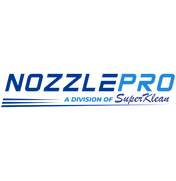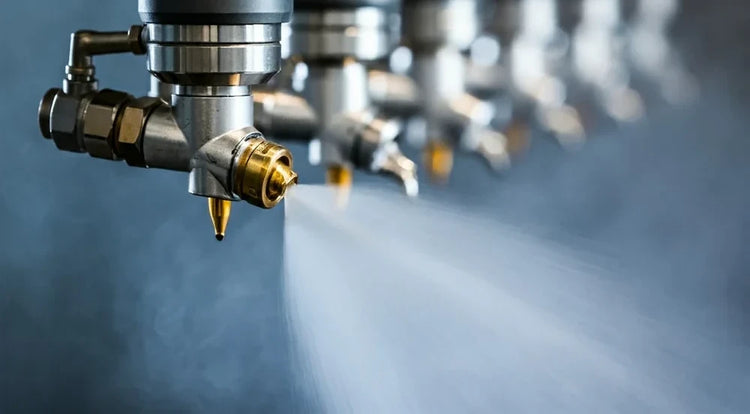Coating Spray Nozzles for Metalworking & Steel Mills
Precision coating application for corrosion protection, surface treatment, and finishing operations—achieve ±5% film thickness uniformity, reduce coating waste 40–60%, and improve product quality with engineered spray systems.
Precision Coating Solutions for the Steel and Metalworking Industry
In steel mills and metalworking operations, coating processes demand exceptional precision to ensure uniform film application that protects products from corrosion, enhances surface performance, and meets strict customer specifications. Even minor inconsistencies—such as bare spots, streaking, or excessive buildup—can lead to costly quality defects, increased chemical use, environmental compliance challenges, and expensive product rework or rejection.
NozzlePro’s industrial spray nozzles and engineered coating systems are designed to deliver consistent, high-accuracy coverage across every stage of production. Our nozzle experts combine optimized nozzle selection, manifold design, and precision flow control to guarantee reliable coating performance in rolling mills, continuous casting lines, galvanizing, painting, and metal finishing systems.
With operating pressures from 0.5 to 50 bar and flow rates between 0.1 and 500 liters per minute, NozzlePro systems achieve ±5% film thickness uniformity across strip widths of 600–2,100 mm. Built for operations processing 50–300 tons per hour, our spray technology for the steel industry minimizes coating waste, improves consistency, and reduces operating costs—ensuring your mill meets the highest standards of efficiency, sustainability, and product quality.
Critical Metalworking Coating Applications
🛡️ Corrosion-Inhibiting Coatings
Precision application of rust preventives, temporary protective coatings, and corrosion inhibitors on steel coils, sheet, and plate. Wide-angle flat fan or air-atomizing nozzles deliver uniform film coverage (0.5–5 g/m²) preventing oxidation during storage and transit. Solvent-based or water-based formulations applied at 2–15 bar ensure complete coverage without runs, drips, or bare spots.
Corrosion Protection →⚙️ Pre-Treatment & Conversion Coatings
Phosphate coating, chromate conversion, and surface preparation chemical application for cold-rolled steel and aluminum. Uniform spray coverage ensures consistent crystal formation, proper coating weight (0.5–3 g/m²), and optimal adhesion for downstream painting or powder coating. Systems accommodate acidic phosphating solutions (pH 2–4) and alkaline cleaners (pH 9–13) with chemical-resistant materials.
Pre-Treatment Systems →🎨 Hot-Dip Galvanizing Lines
Coating weight control chemicals, passivation treatments, and top-coat application on galvanized steel. Precision spray bars apply chromate or chrome-free passivation (5–50 mg/m²), anti-fingerprint coatings, and organic top-coats ensuring uniform coverage at line speeds of 60–200 meters per minute. PLC-controlled flow adjustment maintains target coating weight ±10% across varying strip widths.
Galvanizing Coatings →🏭 Rolling Mill Lubricant Application
Controlled emulsion and lubricant film application for cold rolling, temper rolling, and skin-pass mills. Precision spray headers deliver 0.2–2.0 g/m² coating weight maintaining consistent friction coefficient (µ = 0.05–0.15), preventing roll pickup, and achieving target surface roughness (Ra 0.4–2.5 µm) for automotive body panels, appliance steel, and tinplate substrates.
Mill Lubricant Application →✨ Continuous Coil Coating Lines
Primer, paint, and clear-coat application for pre-painted metal (PPM) production. Air-atomizing and airless spray systems deliver 5–25 µm dry film thickness with ±5% uniformity meeting automotive (ASTM D3359), architectural (ASTM D2794), and appliance specifications. Multi-pass coating with flash-off zones achieves 40–100 µm total build for exterior durability requirements.
Coil Coating Systems →🔧 Specialty Surface Treatments
Release agents, anti-tarnish treatments, edge coating, and functional coatings for specific applications. Examples: silicone release agents for aluminum foil (0.1–0.5 g/m²), benzotriazole anti-tarnish for copper/brass, edge oilers for slit coil protection, and dry-film lubricants for deep-drawing applications requiring enhanced formability without visible residue.
Specialty Coatings →Performance Benefits of Precision Coating Systems
- Uniform Film Coverage – Engineered spray patterns achieve ±5% coating thickness uniformity across full product width, eliminating bare spots, heavy edges, and centerline variations that cause quality defects.
- Reduced Chemical Waste – Precision application reduces coating consumption 40–60% versus flood coating or excess spray application, lowering chemical costs, disposal volumes, and environmental impact.
- Improved Product Quality – Consistent coating coverage enhances corrosion resistance, surface appearance, paint adhesion, formability, and weldability—reducing customer complaints and product returns.
- Line Speed Flexibility – PLC-controlled flow adjustment maintains target coating weight across varying line speeds (30–250 m/min) and product widths without manual intervention or quality compromise.
- Lower Operating Costs – Reduced chemical consumption, decreased waste treatment costs, and improved first-pass yield provide typical ROI of 12–24 months for precision coating system upgrades.
- Environmental Compliance – Minimized overspray, reduced VOC emissions, and lower waste generation simplify EPA, OSHA, and local regulatory compliance while supporting sustainability initiatives.
- Extended Equipment Life – Controlled coating application reduces booth contamination, minimizes nozzle maintenance, and decreases cleaning frequency extending system service life.
- Process Repeatability – Automated spray control eliminates operator variability ensuring batch-to-batch coating consistency supporting ISO 9001, IATF 16949, and customer-specific quality requirements.
Engineering Precision Coating Systems
Application-Specific Parameters
| Application | Nozzle Type | Pressure Range | Coating Weight | Shop Collection |
|---|---|---|---|---|
| Rust Preventives (Temporary Protection) | Wide-angle flat fan | 2–8 bar | 0.5–5 g/m² | Flat Fan |
| Phosphate Conversion Coating | Full cone arrays | 1–4 bar | 0.5–3 g/m² | Full Cone |
| Galvanizing Passivation | Flat fan precision headers | 3–12 bar | 5–50 mg/m² | Flat Fan |
| Cold Mill Lubrication | Flat fan emulsion spray | 2–15 bar | 0.2–2.0 g/m² | Flat Fan |
| Coil Coating (Paint/Primer) | Air-atomizing / Airless | 5–50 bar | 5–25 µm dry film | Air-Atomizing |
| Release Agents (Aluminum Foil) | Fine mist / Hollow cone | 2–10 bar | 0.1–0.5 g/m² | Hollow Cone |
| Anti-Fingerprint Top Coats | Air-atomizing ultra-fine | 1–5 bar + air | 10–100 mg/m² | Air-Atomizing |
Custom Engineering: Final system specifications depend on coating chemistry (viscosity, solids content, surface tension), substrate material and finish, line speed range, environmental conditions, and quality specifications. Request a coating analysis and we'll provide detailed spray layouts, flow calculations, nozzle recommendations, and ROI projections including chemical savings, quality improvement, and waste reduction for your specific application.
Metalworking Coating Types
Temporary Corrosion Protection
Rust preventives and temporary protective coatings for in-process protection, storage, and shipment. Solvent-based (mineral spirits, naphtha) or water-based formulations providing 30–180 days indoor protection or 7–30 days outdoor protection. Examples: light oil films (0.5–2 g/m²), wax-based compounds (2–5 g/m²), and strippable peelable coatings (15–40 g/m²).
Chemical Conversion Coatings
Iron phosphate, zinc phosphate, and chromate conversion treatments providing corrosion resistance and paint adhesion. Coating weights: iron phosphate (100–300 mg/m²), zinc phosphate (1–5 g/m²), and trivalent chromium conversion (5–30 mg/m²). Critical for automotive body panels, appliances, and painted metal products requiring excellent paint adhesion and corrosion resistance.
Functional Surface Treatments
Lubricants, release agents, and specialty coatings enhancing manufacturing processes. Examples: drawing compounds for deep-drawing steel (0.5–3 g/m²), silicone release agents for aluminum foil production (0.1–0.5 g/m²), dry-film lubricants for stamping operations, and anti-tarnish treatments for copper and brass (10–50 mg/m²) preventing oxidation.
Permanent Organic Coatings
Primers, paints, and clear-coats for pre-painted metal (coil coating) applications. Systems: primer (5–10 µm) + topcoat (15–25 µm) achieving 20–35 µm total dry film thickness. Applications: architectural panels (polyester, PVDF), automotive trim (polyester, acrylic), appliance finishes (polyester, epoxy), and specialty products requiring UV resistance, chemical resistance, or specific appearance properties.
Related Steel & Metal Solutions
🔥 Steel Cooling
💧 Lubrication
🔧 Descaling

